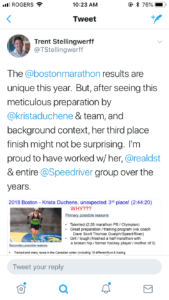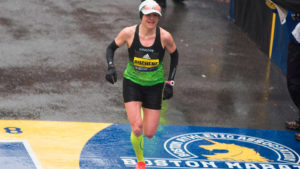The interviews, over twenty so far, have been occupying much of my time, but I’m slowly catching up on sleep and getting back to my normal routine with school lunches, laundry, and parenting. Like second place finisher and nurse Sarah Sellers, I was back to work on Wednesday as a dietitian. I’m enjoying coffee(s) in my pyjamas and although I feel physically fine, I’m allowing my body to completely recover before I return to any sort of physical activity.
I hesitate to start thanking people for fear I will miss someone but it would be terrible of me not to even attempt.
When Jonathan and I returned home, his parents had the house in tip top form. Thank you, Grampa and Grammy for caring for our children while we were away. I knew you would be wonderful grandparents to our children, and fill the void for my parents whom not even your son would meet. I enjoyed reminiscing with you and Jenn about our Boston Marathon experience, thirteen years ago in 2005.
In this post I thought I would share some additional details and updates since writing my initial race report. Even I’ve re-read my own report multiples times to process the events of Patriots’ Day. I think I will start by sharing how I could have possibly achieved a podium finish at the world’s most historic marathon by including a picture of Speed River and the Canadian Sport Institute’s Lead Physiologist, Dr. Trent Stellingwerff’s post on social media.

Race Conditions
It’s normal to have some sort of harsh element to tackle in a marathon, whether it be wind or rain or extreme temperatures. But just as it’s unusual to have none it’s equally unusual to have three. I’ll admit that I routinely complete specific race-pace quality sessions on the treadmill—something that I started years ago when my children were in the Wayne Gretzky Sports Centre childcare but there were many days during this build and in years past that I toughed it out in similar gruelling conditions. I’ve never had the luxury to wait until another time of day to complete my training so I took advantage of the day. In fact, I remember looking out the window on the way to Hopkinton thinking it wasn’t raining hard enough. Yes, our Canadian winters helped and I smiled when I saw someone post the idea that maybe the Africans could come to Canada to train for such conditions.
Carbohydrates
When in England for the London Marathon last year I did something for the first time—I calculated my intake to meet my plan of consuming 8-10 carbohydrates per kg/day for the two days leading up to the marathon. Although I didn’t have a great outcome that day due to a gastrointestinal problem, I knew it was something worth repeating. The John Hancock Elite Program, with leader Mary-Kate, provided excellent care for us, including a menu of the food that would be served throughout the week. Looking at menus when I’m going out to eat a meal that I haven’t had to prepare isn’t unique so checking off what I would consume was actually enjoyable and something to do while filling the time before race day. Increasing my carbohydrates while decreasing my fibre, protein and fat allowed me to top up my glycogen stores. I likely finished my last meal by 7:00 p.m. and was done eating for the night so as to have efficient time for digestion. Around 5:00 a.m. on race morning I ate my white bagel with honey to adequately raise my blood glucose. And at about 20 minutes before the gun I consumed one Endurance Tap gel. During the race I executed the plan I had rehearsed many times in training runs, 19 to be exact this build. I adjusted to the cooler temperatures by drinking about half of the ~ 250 mL (1 cup, 8 oz) of Eload Hydration / Eload Fly fluid in my bottles but consumed nearly all, 6/8, of my gels at each of the 8 stations: 5, 10, 15, 20, 25, 30, 35, and 40 km. There are times I’ve desperately needed that final station but this time I knew I was fine to skip it at a moment I was making my move, unknowingly from 10th to 3rd. I used Reid’s technique of counting sips, and my strategy of drinking, tossing the bottle then waiting to consume the gel so as to slowly ingest and decrease risk of gastrointestinal upset. So basically I fuelled every 2.5 km, which was perfect.

Body Composition
I haven’t listened to the broadcast but have read a variety of comments on social media about the commentators’ references to Body Mass Index (BMI) and use of such words as, “runners’ bodies”, “extra layers” and the like. I realize this is a difficult subject and I’ve hesitated to express my opinions in the past but I think this is a great opportunity to do so. I am an athlete, Registered Dietitian and mom of a young girl, writing “A letter to my daughter” (pg 27) a few years ago. I’ve also provided commentary for marathons. So I have a few angles. For the first time in any marathon build I did not focus on numbers. I truly learned from Coach Dave Scott-Thomas how to train and race by feel. And for the first time I did not weigh myself for the majority of my build. In fact I didn’t weigh myself for nine months. It wasn’t until about three weeks before Boston that I thought it was time to tune into the numbers. Thanks to the expertise of Trent and Dr. Mountjoy with Speed River, I learned and applied how to safely reach an appropriate weight for race day. I tightened up my diet for the last few weeks, even up to the last few days, to reach the number that’s worked for me in the past. I will be honest, it was difficult. My good friend Stacey was a key support for me. For the previous nine months I enjoyed doing what I teach my patients to do—eat mindfully and sensibly, listening to your body and ignoring the scale. I didn’t like returning to the weigh-ins, something that I had freedom from for nearly a year. But I also knew that it was a necessary and short-lived part of the job. In the past I made the mistake of being at “race weight” (yes, I realize some cringe at the mention of the term) for an entire season. Yes, I set personal bests in every event from the 5 km to the marathon that season but I would never do it again. Back then, we knew about the Female Athlete Triad but didn’t have the best understanding of Relative Energy Deficiency in Sport. I had been pregnant or breastfeeding for several consecutive years, which made it complicated. But I didn’t have my menstrual cycle at times when I should have. I hadn’t gone for routine blood work so as to see how my numbers would compare to their own, not to the general population. My diet was lean while training and racing—likely for too long. And in the following season I had my first stress fracture. Thankfully we have people like Anna Boniface who are sharing more and educating others about this delicate subject. And more research is being done in the area of elite women who are pregnant or breastfeeding. We must always keep learning.
As for the commentators’ remarks, I think wiser words could have been used. If you haven’t prepared yourself to speak intelligently about a particular subject, don’t speak at all. In my case, my BMI and race day pace that was closer to my fitness may have been one of the many factors that allowed me to succeed in the cold, wind and rain. But please avoid the use of such terms as “runners’ bodies.” Millions are listening and presuming your remarks are well-researched and accurate. And once you’ve spoken, you can’t take it back.
The Marathon Build and Less is More
Training for this year’s Boston was both my favourite and most efficient build. Ever. I took risk, lived my life, not doing busy work rather focusing on quality. You can read more, about how I was “rolling with it like Denise,” here. While I logged higher mileage last year, including several 180-190 km weeks while in Kenya, I wasn’t quite as successful with the longer marathon-paced workouts then as I was this time. This was my first marathon build at sea-level with Coach Dave and we couldn’t have executed it any better, particularly hitting hill/strides after workouts and including routes with rolling hills on easy days. As for other efficiencies, I likely did far less preventative maintenance this time than ever, in recent years for e.g. decreased my pool running to 30 min/day, five days per week. While I most certainly benefited from and am thankful for the routine work by Paul (physio) and Jason (pilate) at Essential Physiotherapy and David (massage), my green roller was used more to keep the dog off the couch than for anything else. It’s not that I didn’t stretch, roll and do other similar routines, I just went by feel. If I felt like it, I did it. And it likely was only twice a week.
Controlling the Controllables
As I’ve done for years I was consistent with getting appropriate sleep and rest throughout this build. And I maintained an atmosphere of relaxation in the final days leading up to the race. I left a list for Grammy and Grampa, but let it go once I got on the plane. They could figure out the details and adapt without us, even with the many cancellations due to the ice storm they were having. The other thing I let go that I couldn’t control was the timing of my menstrual cycle. The last few marathons I’ve been due to get my period on race day but skipped it until the following month (and for the only time in that 6 month time). But not this time. Yes, I got my period the day before the Boston Marathon. The timing couldn’t have been worse but it didn’t seem to matter. I once read that Paula Radcliffe had her cycle when she set the world record so was prepared to use that as comfort should it happen to me. I told Reid’s wife, Marie, and I can’t remember exactly what she said but it was something like, “Well, with this predicted weather, it may not make any difference.” I agreed with her and didn’t think much about it after that.
Channelling your Emotions
Based on my experience from running the 2005 Boston Marathon, I knew the energy from the crowds would be intense. In the stories leading up the race I had been asked about the Boston bombing and more recent Humboldt, Saskatchewan Jr. Hockey Team bus crash that took the lives of 16 people. I was quoted saying, “Marathon running can be a good opportunity to draw upon your emotions if you can channel them properly. There’s a lot of emotional things I can channel to give me the energy and knowing I’m from Canada, and even if that message gets to one person in Humboldt that I was thinking of them, that’s the least I can do for them.”
“The day my husband and I flew to Boston we wore our jerseys and put our sticks out on the front porch and our kids wore their jerseys to school. At the airport not many people knew in the U.S. why we had jerseys on, they probably thought we were Canadians who loved hockey. That’s just one opportunity you can be proud of your country and in Humboldt everyone has come together to help them, not just people from the provinces but the whole world.”
Grit and Toughness – Age, Broken Bones, and Being a Mom and Former Hockey Player
It’s nothing new that endurance events are more suited to those in their 30’s and beyond. But it’s likely more the experience and wisdom that has come with running marathons for 16 years that contributed to my success in Boston. Being patient and truly confident to execute your plan isn’t something that comes easy to the rookie. The intense pain from labour, childbirth, and broken bones has allowed me to know that no pain from any marathon even comes close. My time of 2:44 was certainly no record but I think that having two anti-doping control officers be assigned to the same person at the Boston Marathon may have been (one for overall placing and one for masters placing). Meb was 38 when he won the 2014 Boston Marathon, which is incredibly inspirational but it’d be neat to learn how many podium finishers were 40+.
Saucony
I don’t believe in luck but I do know that green has been a good racing kit colour for this year’s Boston Marathon performance and when I ran my Personal Best of 2:28:32 in 2013 to become second fastest Canadian at my favourite Scotiabank Toronto Waterfront Marathon. A big thank you to Saucony for supporting me since 2009.
#TeamDuChene
What an incredible husband I have. Really. He has been a listening ear and offered his advice at the most appropriate times, first suggesting I get a coach back in 2009 when I was given the name, “Marathon Mom” after winning the Mississauga Marathon on Mother’s Day, less than two years after the birth of our second son. It was also then that he wrote a letter to Chariot-Thule on my behalf, earning me a double running stroller I would log hundreds of miles pushing. His jokes as my agent/manager continue to keep me laughing but most notably, he leads and loves our family with incredible character and selflessness. Our three amazing children whom I so grateful for see a man live a life of amazing integrity. They are wonderful human beings because of his great example. When he saw me shaking in the medical area at the Fairmount Copley after the finish and I said, “They’re telling me I’m third” (like it was a joke) he shrugged his shoulders as he was less concerned about that and more about getting me dry clothes and my passport for anti-doping, which I didn’t pack because I figured I wouldn’t need it. Many have asked what we will do with my prize money and without thinking, 10% will go to our church. I thought saving it for another European vacation after a marathon might be fun. But like many other times he’s given wise advice, he said “Well, if you are serious about Tokyo 2020 and want us to go, we’d better start saving”. I have no good reason not to.
Home
There has been some confusion as to where I call home. My passport says Strathroy, which appears on the Team Canada Olympic website. I spent my entire childhood on a beef farm outside Alvinston. I lived in Guelph for 5 years while at University and in Kingston for 1 year when completing my dietetic internship. But Brantford is where we’ve lived the last 16 years.
Lastly and Most Importantly – My Faith
I have no numbers for this. No scientific proof. I can only live by example so that others can see it to believe it. During many difficult trials my sister has lovingly sent me encouraging messages with bible verses and I’m immensely grateful. I’ve grown far more in my faith during these times than ever. And it’s helped me be a true inspiration to others.
“I believe God made me for a purpose, but he also made me fast! And when I run I feel his pleasure.” – Eric Liddell
Ephesians 3:20 God can do immeasurably more in us than we could ever ask or imagine.
















 Our Magazine
Our Magazine
